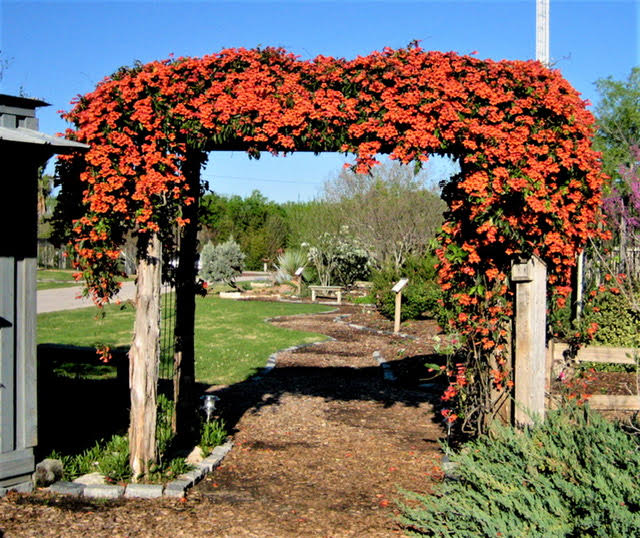By Grace Broyles
Big Country Master Gardener
A new favorite of mine, the Cross Vine, delights me more and more as I work with it. At first, I was skeptical of this vine that didn’t seem to me to meet the ooooohs and aaaaahs of those who had it planted on their fence lines and other vertical structures. But now it is a favorite, especially after the last couple of winters, when the vine I had been babying kept most of its leaves, and those leaves were a lovely dark green with a deep burgundy hue. It also spread across the chain link fence it was growing on without getting too bushy, and requires little maintenance. I enjoy its trumpet-like flowers, especially the dark orange ones, when the vine puts on its abundant first splendor in the spring.
I first came across it about ten years ago when a customer had it growing on his chain link fence in soil that was covered with pea gravel. It covered the fence line very well, making a perfect screen, but was also very “hairy.” It needed regular snipping back into its space. But its flowers were very appealing–trumpet-like and orange and in abundance when moisture and sun were plentiful.
Then two years ago, the Tangerine Beauty Cross Vine was named a new Texas Superstar, for its striking color, evergreen foliage, hardiness, and its ease for growers to propagate. And this designation has panned out in the Abilene area.


This vine is a native Texas vine, and a member of the Trumper-creeper family. It can produce up to 50-foot-long vines that climb well due to its tendrils, and can climb up walls and adhere to brick and rock with its claw-like pads. It is found growing naturally in forested areas of east Texas, and in westernmost central Texas. It was used by the native Americans as a remedy for various ailments including diptheria and rheumatism. The Latin genus name, bignonia, was given in honor of King Louis XV of France’s librarian, Jean Paul Bignon. Its species name, capreolata, describes the tendrils that have a unique winding and twisting habit. It is called “Cross Vine” because of the design of the pith when the stem is cut.
The Cross Vine comes in several selections at nurseries, but many varieties have been found in the wild and have been transplanted by gardeners into their gardens. It was first discovered in the 1980s by Texas horticulturist and garden writer Scott Ogden, in a San Antonio Garden.
So how to propagate this beauty, that will thrive in almost any type of soil, in full sun or partial shade?
In the spring or early summer, snip off 6-8 inches of the new growth but firm stem, leaving only a couple of leaves at the tip, or take a root cutting several inches long. Dip cuttings in growth hormone, if you have it on hand. Then place in a pencil-poked hole in a small 6-inch pot of an organic soil mixture. Tamp the soil somewhat firmly around the cutting and keep it moist. In 4 to 6 weeks, new growth should appear.


Or take the browned seed pods off the vine, remove the seeds, and plant in a small pot in a mixture of moist fast-draining soil about 1 to 2 inches deep. A good mixture is peat, coarse sand and perlite. The new seedlings should begin appearing in about 3 weeks. In both types of propagation, keep the seedlings moist and give the seedlings time to firmly establish themselves, then transplant them to a sunny location. Be sure to keep the soil moist for a several seasons, and especially before a freeze.
The new little vines will be a wonderful addition to a landscape that needs color and height or length or a screen that will last many years in a sometimes harsh West Texas climate.
If you have any questions, call the Taylor County Extension Office at 325-672-6048 or email us at mgardeners@yahoo.com. We hope you visit bcmgtx.org for information on all Big Country Master Gardener events, like us on BCMGA Facebook, and check out training presentations on Big Country Master Gardener Association on YouTube. We are here to help you.



